Wooden sinks: features and step-by-step manufacturing instructions
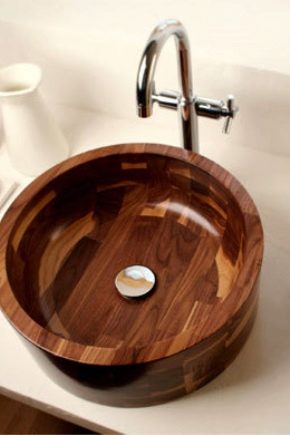
With the development of modern production technologies, over the past century and a half, we have become accustomed to sanitary ware made of ceramics and metal, which will surprise no one. The most elaborate porcelain and earthenware models have become commonplace. Stainless light steel for kitchen sinks has replaced heavy enamelled cast iron.
To give the home exclusivity, they try to use unusual materials or use them in an unusual design. So, sinks made of glass or natural stone are considered an extraordinary design solution. They can be quite expensive. And what about the tree? According to many, wood is difficult to imagine in plumbing - it can only serve as furniture or a decorative element. However, this is a big misconception, and modern designers successfully destroy this myth.


Peculiarities
Since ancient times, wooden objects and coatings have been widely used in household use. It is an excellent material for the construction of houses, baths, utility rooms. It is difficult to imagine a real Russian bath without wooden containers for water: barrels, tubs, fonts. Wood interacts well with water, and with proper processing of the material, it can last for many years. Wood fiber is environmentally friendly, gives the room a peculiar aesthetics, and can also emphasize the interior design. For this reason, wooden sinks for washbasins have become especially popular lately. In its finished form, the wooden sink takes on a stylish gloss. Such a model can become one of the main design accents of the room.
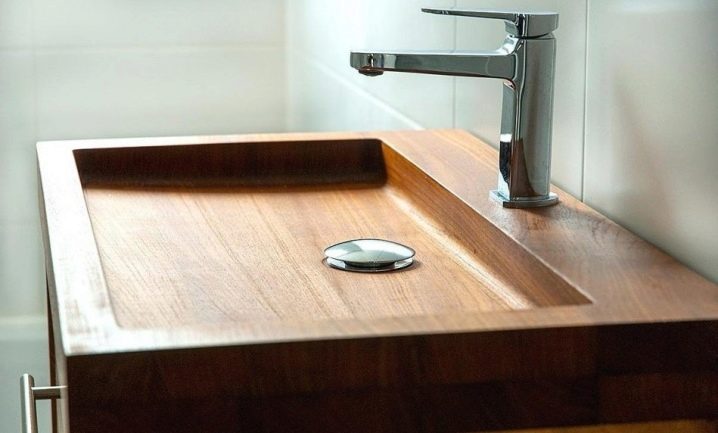
Of course, in order for a wooden sink to look stylish and retain the functionality of the material for a long time, the wood must undergo special processing. That is why in the production of such products during polishing, a multilayer protection with varnish and certain compositions is used, which makes it possible to increase the resistance of wood to water.
Another feature of wooden sinks is the property of the material to acquire a darker shade over time. This factor is individual for each breed. Manufacturers interested in the quality of their products will certainly offer and advise a set of products that can preserve the original shades of wood. Some models of sinks require mandatory periodic treatment with special oils.
The main rule of caring for a wooden sink is to avoid harsh cleaners that contain abrasive substances in their composition.
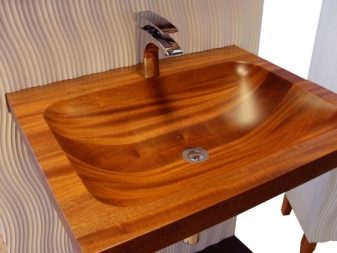

Materials (edit)
Wood is a natural material. Like all life on the planet, it is associated with water. From seed growth to wood processing, water is constantly present somewhere nearby. In the old days, it was from wood that ships were built, timber was floated along rivers, some types of wood were processed by soaking or flooding. For example, after prolonged soaking, oak acquires special strength, so the myth that wood cannot be combined with water does not stand up to the test of facts.
Over time, craftsmen have empirically determined which tree species are most suitable for interacting with water. Nowadays, sinks are made from the following materials.

Oak
One of the most durable types of wood, which gains additional strength from water.It was from it that the first water pipes were made in medieval Europe. Oak has a wide range of shades, which allows you to choose the perfect option for every taste.
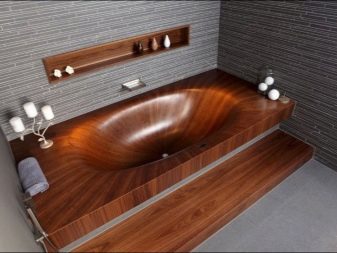
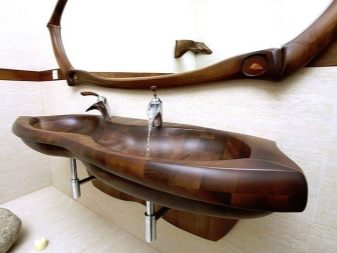
Teak
A valuable material that has a high rubber content. Thanks to this property, teak sinks have additional water-repellent properties. The oily substances in this wood prevent the formation of mold and mildew. Under the influence of water, wood does not darken over time, retaining its original shade.



Bamboo
A durable material with a wide range of colors from the lightest to the most intense dark shades. Bamboo is somewhat cheaper than oak and teak, as it does not fully fall under the definition of "wood".



Hardwood
The most economical option, since the products made from them are not so refined and durable. However, maple, birch, acacia or walnut wood lends itself well to processing, takes any shape, and under the influence of special compounds it becomes quite strong. In production, the method of pressing and gluing small particles of wood, impregnation with wax and oils, lamination is used. But the product can also be made from a solid wood with subsequent processing and impregnation.


Style directions
First of all, wooden sinks are able to accentuate the style of rooms oriented towards natural wood.
Wood goes well with any other materials, so items from:
- glass;
- natural stone;
- metal.
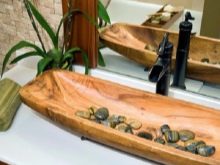


Designers' favorite styles to incorporate wood sinks into interiors.
- Country;
- Eco;
- Ethno.
- The rustic motif of the design will sparkle with new colors if you add a wooden washstand decorated with carvings to the style of the "Russian hut" or American country.
- Stylish sinks made of wood will decorate the style of the chalet, give it nobility without detracting from the natural environment.


- Rustic style rough wood will add brutality, especially in combination with rough stone.
- The tenderness of Provence will be emphasized by a bleached oak sink and a forged ornament with patina or gilding.
- A natural element will be added to the eco style, which cannot be found in such an interior. An eco-style vanity unit can be made of natural or artificial rattan.
- But sophisticated classics are not alien to the unusual manifestation of the shapes and textures of wooden sinks. Clear geometric shapes, shining varnish on noble wood will look truly luxurious and respectable.
- But for ultra-modern styles, it is better to choose another material, closer to artificial raw materials and the latest technologies.

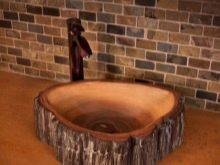

DIY sink
Making a sink for a house in a village with your own hands will not be difficult if you have the skills of carpentry. The main advantage of such a product will be in its originality and a piece of your creativity. The simplest option is to cut the container out of solid wood or well-glued beams.
Step-by-step instructions will allow you to understand how to make a sink yourselfhaving school knowledge from the lessons of labor.
- Decide on the size and material. The width and depth of the container will depend on your preference and the availability of linen available.
- After cleaning the top layer of wood, apply the markings according to a prepared plan.
- Using a circular saw, cut a recess in the solid along the contour. Remember to calculate the depth so you don't cut right through the tree.
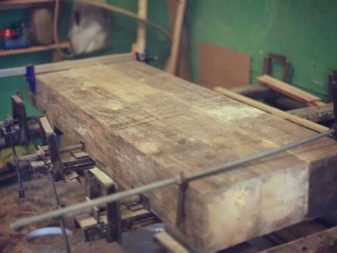



- Use a chisel and hammer to remove excess wood particles.
- Give the container a smooth surface with a sanding disc, additionally sand the wood to remove small burrs.
- Cut a drain hole at the designated location.
- The resulting sink must be treated with an epoxy resin composition, and then applied with a polyurethane coating. This will create a waterproof layer.
- Once the varnish has dried, your unique sink is ready to be installed and connected to the waste system. You can also give it an unusual look by coming up with your own design and shape.
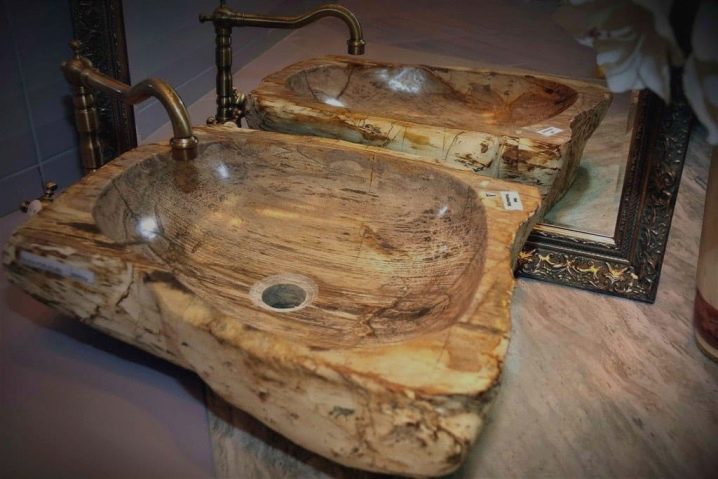
Subtleties of care
Despite its strength, wood is a rather demanding material that requires careful handling and special care, so the methods of use and cleaning that are usual for earthenware and metal will not work here.
In order for the sink to serve for a long time, you must follow some rules of care and operation.
- Do not put hot objects, do not pour boiling water. Wood is exposed to high temperatures, so unattractive marks can remain on the surface of the sink.
- The sink is cleaned only with soft sponges and antibacterial non-alkaline compounds. Aggressive substances can eat in and then destroy the structure of wood and coatings; therefore, the use of abrasive cleaning agents with chlorine and bleaching agents is excluded.
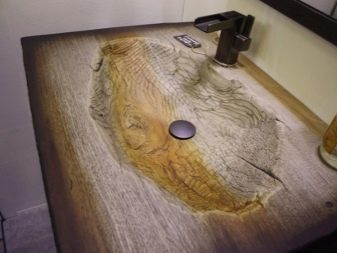

- Interaction of the surface with sharp objects that can scratch the protective layer is undesirable;
- Avoid the ingress of particularly fatty residues of products, as their subsequent removal can cause certain difficulties;
- Wooden sinks should not be used in the kitchen, where there is a high risk of grease or boiling water getting on the surface;
- It is necessary to carry out periodic processing of the sink with special compounds, including oils and wax. Preventive treatments are carried out every three months. This will extend the life of the product, as well as preserve its water repellency and color.
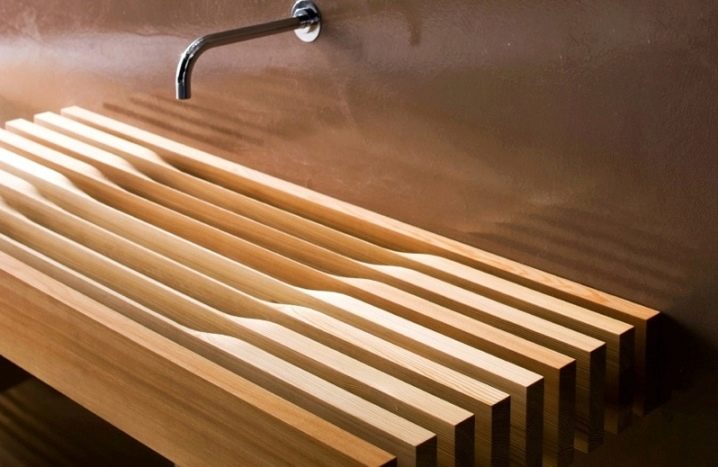
You can find out how wood sinks are made in the next video.













The comment was sent successfully.